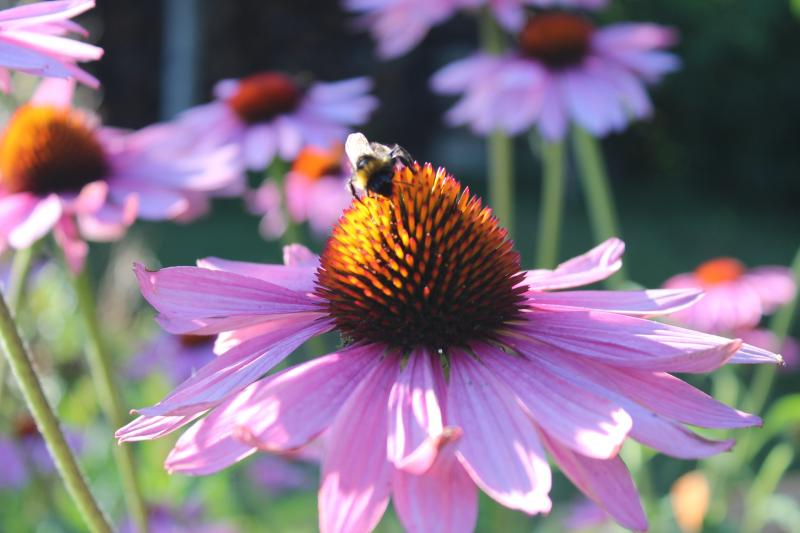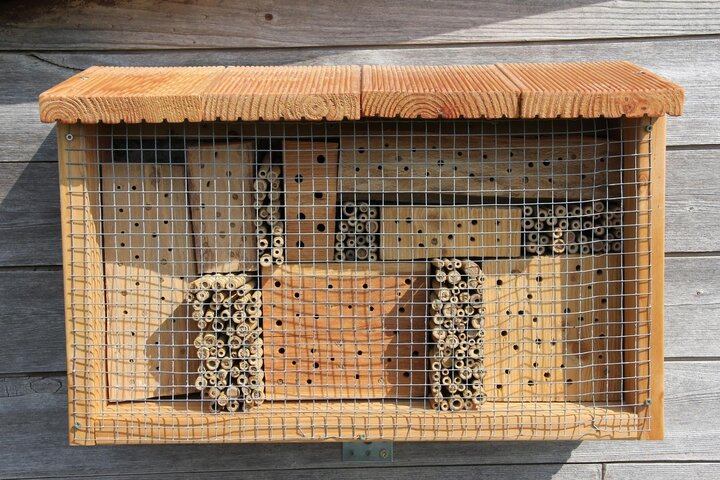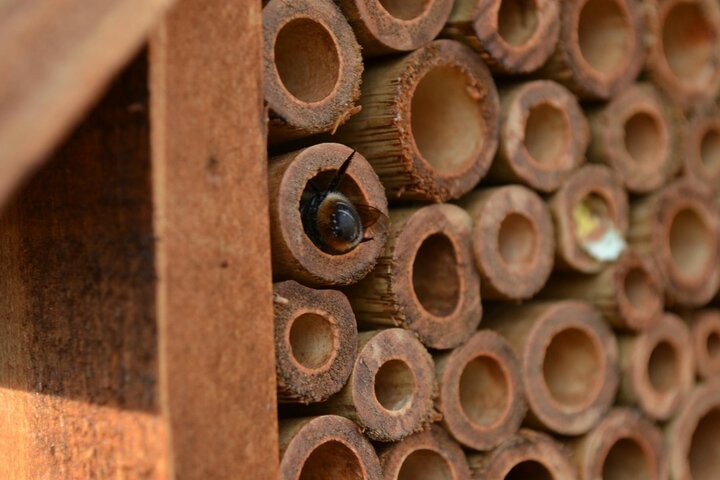Sarah Browning, Nebraska Extension Educator

Mason Bee on a Beautiful Coneflower - Picture by Pixabay.com
Honey bees and other bee species, such as bumblebees, orchard mason bees, and leafcutter bees are very important pollinators of flower and crops. In the home garden and orchard, gardeners are aware how important bees are for fruit and vegetable production. But in recent years many gardeners have noticed declining bee numbers in their gardens and nationwide bee deaths have been big news, making colony collapse disorder a familiar phrase.
Bees are threatened by habitat loss, chemical use, parasitic mites and disease. Gardeners may not want honey bee hives in their backyard, they can encourage the less aggressive bumblebees, orchard mason bees and other native bees to take up residence. Bumble bees are particularly efficient pollinators of tomatoes and cucumbers, so having a nest of bumble bees in the garden can be beneficial.

Create Native Bee Habitat
One great way to do this is by planting habitat to encourage native bees. Bumble bees are generalist foragers, gathering pollen and nectar from a variety of flowering plants, but they do have a preference for purple, blue or yellow flowers. They are essentially blind to the color red, so don't forage on red flowers unless there are ultra violet pigments on the flower petals. Bumble bees also have a strong preference for the flowers of perennial plants, over the flowers of annual plants. Perennial flowers tend to have high amounts of nectar.
Plants that are particularly good choices to create bumble bee habitat include the following.
- Spiderwort, Tradescantia ohiensis, flowers May through August
- Purple prairie clover, Dalea purpurea, flowers May through July
- Showy beardtongue, Penstemon cobaea, flowers April through May
- Large-flowered penstemon, Penstemon grandiflorus, flowers May through June
- Smooth penstemon, Penstemon digitalis, flowers May through July
- Beebalm, Monarda fistulosa, flowers May through September
- Butterfly weed, Asclepias tuberosa, flowers May through September
- Narrowleaf mountain mint, Pycnanthemum tenuifolium, flowers June through September
- Showy goldenrod, Solidago speciosa, flowers August through September
- Bottle gentian, Gentiana andrewsii, flowers August through October
- Tall blazing star, Liatris aspera, flowers August through October
- New England aster, Symphyotrichum novae-angliae, flowers August through October
- Canada goldenrod, Solidago canadensis, flowers September through October
For more information on creating habitat, check out Attracting Pollinators to Your Landscape. This publication includes great information on creating a bee habitat structure with recycled materials. Follow along this summer through UNL Extension in Lancaster County's blog The Buzz at Cherrycreek and see if the bee habitat is colonized.
Protect Bees from Pesticides
Most bee deaths occur when pesticides are applied to flowering crops, such as fruit trees, squash, melons and other flowering vegetables, or flowering plants. Pesticides vary in their toxicity to bees. Most fungicides and herbicides have relatively low toxicities to bees.
Tolerate minor insect damage in your landscape to avoid pesticide use and allow bees to thrive.
If insecticides are needed in your landscape, apply them selectively avoiding plants of greatest interest to bees. Do not broadcast insecticides throughout the landscape. Do not apply insecticides with a high toxicity to bees when bees are foraging, instead wait until evening, around dusk, to make applications. Bees should have left plants by that time of day. A few products with high toxicity to bees include imidacloprid, bifenthrin, permethrin (Eight), cyfluthrin, and carbaryl (Sevin).

Build a Bee House
According to Doug Golick, UNL Assistant Professor of Entomology, one limiting factor in bumble bee success is the lack of availability of nesting sites. Bumble bees do not build their own nest, instead they use abandoned rodent dens to establish a colony. Competition for these nest sites is often high, with queens killing each other for control of a natural nest site. The more nesting sites available the greater chance for bumble bee queens to establish a colony.
Download building plans for your own bumble bee domicile.
Finally, consider becoming a member of Bumble Bee Watch, a collaborative effort to track and conserve North America's bumble bees. This citizen science project allows individuals to:
- Upload photos of bumble bees to start a virtual bumble bee collection;
- Identify the bumble bees in your photos and have your identifications verified by experts;
- Help researchers determine the status and conservation needs of bumble bees;
- Help locate rare or endangered populations of bumble bees;
- Learn about bumble bees, their ecology, and ongoing conservation efforts; and
- Connect with other citizen scientists.
Images from Pixabay.com.
- Provide additional nesting sites by building a bee hotel.
- Mason bee laying eggs in a hollow stem.